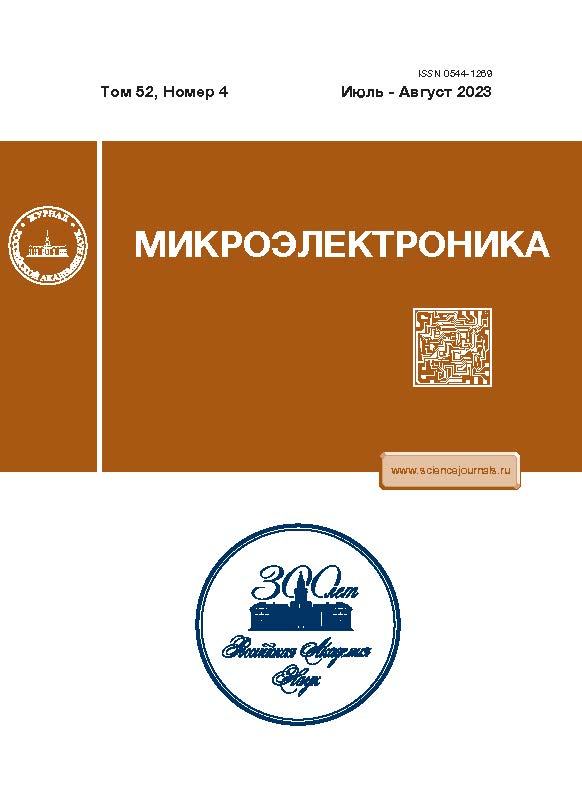Study of the Sensor Properties of Ordered ZnO Nanorod Arrays for the Detection of UV Radiation
- Authors: Evstafieva M.V.1, Knyazev M.A.1, Korepanov V.I.1, Red’kin A.N.1, Roschupkin D.V.1, Yakimov E.E.1
-
Affiliations:
- Institute of Problems of Microelectronics Technology and High-Purity Materials, Russian Academy of Sciences
- Issue: Vol 52, No 4 (2023)
- Pages: 322-328
- Section: СЕНСОРЫ
- URL: https://journals.rcsi.science/0544-1269/article/view/138577
- DOI: https://doi.org/10.31857/S0544126923700436
- EDN: https://elibrary.ru/HZVUIQ
- ID: 138577
Cite item
Abstract
Zinc oxide is one of the most promising materials used to create devices in the ultraviolet (UV) range. In this article, we study the sensor properties of ordered ZnO nanorod arrays grown by chemical vapor deposition. The possibility of their use as an indicator of UV radiation to control the dose of UV radiation, both from natural and artificial light sources, is assessed. The X-ray diffraction, Raman spectroscopy (RS), and cathodoluminescence (CL) data demonstrate the high quality of nanorods. Based on the ZnO nanorod array, a sensor prototype was fabricated based on the change in ZnO conductivity under the UV irradiation. A compari-son of the response of such a sensor with the readings of a UV radiometer showed a high correlation.
About the authors
M. V. Evstafieva
Institute of Problems of Microelectronics Technology and High-Purity Materials, Russian Academy of Sciences
Email: ryzhova@iptm.ru
Chernogolovka, Moscow region, 142432 Russia
M. A. Knyazev
Institute of Problems of Microelectronics Technology and High-Purity Materials, Russian Academy of Sciences
Email: ryzhova@iptm.ru
Chernogolovka, Moscow region, 142432 Russia
V. I. Korepanov
Institute of Problems of Microelectronics Technology and High-Purity Materials, Russian Academy of Sciences
Email: ryzhova@iptm.ru
Chernogolovka, Moscow region, 142432 Russia
A. N. Red’kin
Institute of Problems of Microelectronics Technology and High-Purity Materials, Russian Academy of Sciences
Email: ryzhova@iptm.ru
Chernogolovka, Moscow region, 142432 Russia
D. V. Roschupkin
Institute of Problems of Microelectronics Technology and High-Purity Materials, Russian Academy of Sciences
Email: ryzhova@iptm.ru
Chernogolovka, Moscow region, 142432 Russia
E. E. Yakimov
Institute of Problems of Microelectronics Technology and High-Purity Materials, Russian Academy of Sciences
Author for correspondence.
Email: ryzhova@iptm.ru
Chernogolovka, Moscow region, 142432 Russia
References
- Altmeyer P., Hoffmann K., Stücker M., Freitag M. Skin Cancer and UV Radiation. Springer; 1997.
- Özgür Ü., Alivov Y.I., Liu C., Teke A., Reshchikov M.A., Doğan S. et al. A comprehensive review of ZnO materials and devices // J. Applied Physics. 2005. P. 041301. https://doi.org/10.1063/1.1992666
- Yi F., Liao Q., Yan X., Bai Z., Wang Z., Chen X. et al. Simple fabrication of a ZnO nanorod array UV detector with a high performance // Physica E Low Dimens Syst Nanostruct. 2014. V. 61. P. 180–184.
- Rodwihok C., Choopun S., Ruankham P., Gardchareon A., Phadungdhitidhada S., Wongratanaphisan D. UV sensing properties of ZnO nanowires/nanorods // Applied Surface Science. 2019. P. 159–165. https://doi.org/10.1016/j.apsusc.2017.11.056
- Sang L., Liao M., Sumiya M. A comprehensive review of semiconductor ultraviolet photodetectors: from thin film to one-dimensional nanostructures // Sensors. 2013. V. 13. P. 10482–10518.
- Wei A., Pan L., Huang W. Recent progress in the ZnO nanostructure-based sensors // Materials Science and Engineering: B. 2011. P. 1409–1421. https://doi.org/10.1016/j.mseb.2011.09.005
- Kushwaha A., Aslam M. Defect induced high photocurrent in solution grown vertically aligned ZnO nanowire array films // J. Applied Physics. 2012. P. 054316. https://doi.org/10.1063/1.4749808
- Reddy N.K., Ahsanulhaq Q., Kim J.H., Devika M., Hahn Y.B. Selection of non-alloyed ohmic contacts for ZnO nanostructure based devices // Nanotechnology. 2007. V. 18. P. 445710.
- Serrano J., Manjón F.J., Romero A.H., Widulle F., Lauck R., Cardona M. Dispersive phonon linewidths: the E2 phonons of ZnO // Phys Rev Lett. 2003. V. 90. P. 055510.
- McCluskey M.D. Defects in ZnO. Defects in Advanced Electronic Materials and Novel Low Dimensional Structures. 2018. P. 1–25. https://doi.org/10.1016/b978-0-08-102053-1.00001-6
- Shasti M., Dariani R.S. Study of growth time and post annealing effect on the performance of ZnO nanorods ultraviolet photodetector // J. Applied Physics. 2017. P. 064503. https://doi.org/10.1063/1.4975674
- Redkin A.N., Yakimov E.E., Evstafieva M.V., Yakimov E.B. Grown and characterization of ZnO aligned nanorod arrays for sensor applications // Energies. 2021. V. 14. P. 3750.
- Hullavarad S., Hullavarad N., Look D., Claflin B. Persistent Photoconductivity Studies in Nanostructured ZnO UV Sensors. Nanoscale Research Letters. 2009. https://doi.org/10.1007/s11671-009-9414-7
- Al-Asadi A.S., Henley L.A., Ghosh S., Quetz A., Dubenko I., Pradhan N. et al. Fabrication and characterization of ultraviolet photosensors from ZnO nanowires prepared using chemical bath deposition method // J. App-l. Phys. 2016. V. 119. P. 084306.
- Barbagiovanni E.G., Strano V., Franzò G., Crupi I., Mirabella S. Photoluminescence transient study of surface defects in ZnO nanorods grown by chemical bath deposition // Applied Physics Letters. 2015. P. 093108. https://doi.org/10.1063/1.4914067
- Li Y., Della Valle F., Simonnet M., Yamada I., Delaunay J.-J. Competitive surface effects of oxygen and water on UV photoresponse of ZnO nanowires // Appl. Phys. Lett. 2009. V. 94. P. 023110.
- Li Y., Della Valle F., Simonnet M., Yamada I., Delaunay J.-J. High-performance UV detector made of ultra-long ZnO bridging nanowires // Nanotechnology. 2009. V. 20. P. 045501.
Supplementary files














